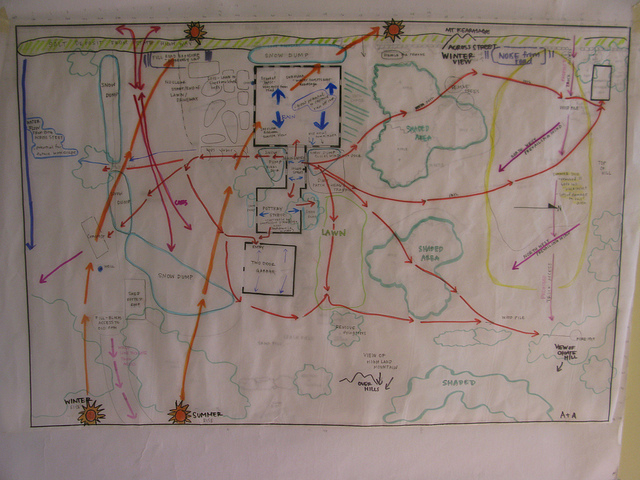
This article is part of the Redesigning Society series. Over the coming weeks, this series will present a range of expert perspectives on the current state of societal affairs, as well as the collective changes we desperately need both philosophically and practically. Details of upcoming and past guests and topics can be viewed here. You can subscribe to The Conscious Society Youtube Channel to get early access to each interview in the series.
Humanity has lost its connection to nature.
We’re so bombarded with artificial imagery and superficial living that we think that taking in the sunset or going for a bush-walk is all it means to unite with our mother earth.
These practices are in and of themselves a great experience, however they don’t truly represent the holistic way in which we should be connecting to the spirit of the natural world and the life that it breathes.
We have disconnected from our food. We have forgotten the cycles of natural systems. We are blind to the divine patterns found in nature. We hardly recognize the innate wisdom of knowing our environment like the back of our heart.
The urbanization of civilization is partly the cause. Living in a cement jungle on top of each other, as well as the rise of social media, is an ironic twist to being more isolated from each other and our environment. The reality is, the way in which we should be engaging with our local community has been inhibited by the organisational systems that the majority of us subscribe to. And for what? To feed the elite’s unsustainable and destructive economic principle of growth by attending a monotonous job from nine to five, one which the bulk of us don’t even enjoy?
Consumerism has harmed our collective and environmental well-being. Materialism has eroded our value systems and fueled a cultural existential crisis. Globalization has polluted our planetary and community health. Industrial agriculture is killing our ecological systems and failing to feed the human population.
There have to be other ways—there are other ways. One is called permaculture.
Permaculture is a practice that provides most of our resources locally. It starts with ethics: What is truly right for our individual, community and environmental health? How can we provide the basic needs of humanity whilst doing it in balance with nature?
Then it becomes a design science. Designing permaculture plots includes a process of surveying the local environment, identifying its patterns, decoding the inherent wisdom that it contains, and combining that and other knowledge with technological innovation to efficiently and effectively collaborate with natural systems to provide all the food, medicine, fibre and fuel that we need.
This not only ensures that we survive, but psychologically thrive.
So in a sense, permaculture is an art. It’s an expression of human ingenuity in its most glorious form because it’s the creation of a painting that reflects the way in which humans and nature become one. The external world is the canvas, human novelty is the paint and the human heart is the paintbrush.
And no matter where we live on our planet, we can create a masterpiece.
Permaculture has conclusively shown that it can produce quality and sustainable results in any region on earth. It utilizes the local energy—such as water, solar, soil and biological—in the most productive ways possible. It can generate an abundance of resources in cold, hot, wet, dry and other challenging conditions. It has conquered the mountains, the plains, the jungle and the desert, without missing a beat.
This is exactly why permaculture is a system that can easily feed the entire population of the world. Whilst doing so, it leaves no toxic trace, as it doesn’t require the environmentally damaging oil products that industrial agriculture relies on. It uses natural remedies to deal with the imbalances local to each area, such as flora and fauna pests.
Permaculture incorporates the advancements made in sustainable and renewable technologies. But it also honors ancient technologies too, such as natural building materials. For example, housing can be created out of local, inexpensive and sustainable resources.
It also integrates communities. Instead of going to a multinational supermarket to get your food, we go to our backyard and pick it fresh to cook in our own kitchen, or trade for ingredients that our neighbours grow. All-inclusive community gardens can also be designed as a meeting place to teach each other and our kids not only what we’re eating, but how to grow and nurture it.
So with a permaculture approach applied on both an individual and community level, basically no one will go hungry and everyone will be adequately housed. There will be little social isolation. Problematic behaviors from disenfranchised adults and youth would decrease. Local economies, based in quality interactions, would thrive, as would the happiness of the people. And our natural systems would diversify and flourish too.
Permaculture is simply a solution for so many of the world’s problems.
The Way Forward? Connect with a Permaculture Movement Near You
An interview with Permaculture icon, Geoff Lawton:
Geoff is an expert in this growing field. Since the mid-nineties he has specialized in all things permaculture, including the education, design, implementation, system establishment, administration and community development of it across the world. He is a true leader in building a sustainable and healthy future for humanity.
In the video he moves through many aspects of permaculture, including its positive environmental, practical, cultural and philosophical impacts. He talks about the patterns of nature, the nutritious diversity of food it can provide, the values it endorses, the quality of living it offers and the meaning and hope it can give to one’s life:
“It feels like that the meaningful, interesting, intense engagement that you get involved in, that’s very relative to you and your health…expands time. Now, wow! If you could bottle that up and sell it as a product it would be a best seller! That’s what this is. I mean, it has great purpose. And with our online course I get a lot of endorsements…(such as) you’ve changed my life; this has given me total meaning; this has put so much knowledge together I’ve already got in a format I can now engage in; I feel like there’s hope.”
Simply, that’s the progressive effect that permaculture can have on a society that is increasingly suffering.
The Verdict
Geoff summarises beautifully why permaculture isn’t just good for the earth, but good for the soul of humanity. It can provide the food and other physical resources we need, as well as the psychological and philosophical health resources too.
To learn more about its nuts and bolts, read here. And don’t forget to lock this in: permaculture is a grass roots movement that empowers individuals and entire communities to help overcome a long list of problems that we collectively face.
“(Permaculture is) a connecting system…that’s incredibly valuable to get us out of the problems we’re in, in so many ways. The environment, the people, the social order; we will never have good social order until we design our way out this problem ourselves. No one’s coming to help us, we’re going to have to do this ourselves, together, everybody”.
Relephant Read:
Redesigning Society: 3 Scientific Fields that are Evolving Humanity’s Worldview.
Author: Phillip Watt
Editor: Emily Bartran
Photo: Ryan/Flickr






Read 1 comment and reply